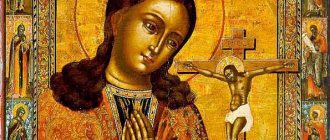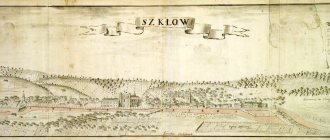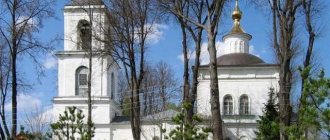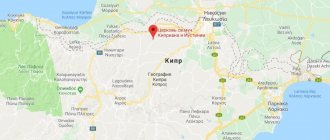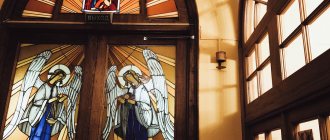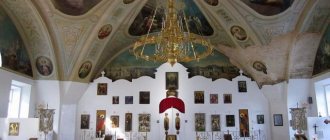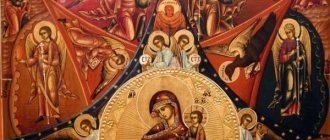Mir
Russia Moscow region Dubrovitsy village Church of the Icon of the Mother of God “The Sign” (Dubrovitsy) Map is loading…
{"format":"leaflet","minzoom":false,"maxzoom":false,"limit":50,"offset":0,"link":"all","sort":[""], "order":[],"headers":"show","mainlabel":"","intro":"","outro":"","searchlabel":"\u2026 \u0441\u043b\u0435\ u0434\u0443\u044e\u0449\u0438\u0435 \u0440\u0435\u0437\u0443\u043b\u044c\u0442\u0430\u0442\u044b","default":"","import-annotation":false,"width ":"auto","height":"350px","centre":{"text":"","title":"""link":"""lat":55.44129720000000105528670246712863445281982421875,"lon": 37.494408300000003464447217993438243865966796875,"icon":""},"title":"","label":"","icon":"","lines":[],"polygons":[],"circles":[ ],"rectangles":[],"copycoords":false,"static":false,"zoom":8,"defzoom":14,"layers":["OpenStreetMap"],"image layers":[] ,"overlays":[],"resizable":false,"fullscreen":true,"scrollwheelzoom":true,"cluster":false,"clustermaxzoom":9,"clusterzoomonclick":true,"clustermaxradius":80, "clusterspiderfy":true,"geojson":"","clicktarget":"","showtitle":true,"hidenamespace":false,"template":"","userparam":"","activeicon": "","pagelabel":false,"ajaxcoordproperty":"","ajaxquery":"","locations":[{"text":"\u003Cb\u003E\u003Ca href=\"/palomnik/%D0% A6%D0%B5%D1%80%D0%BA%D0%BE%D0%B2%D1%8C_%D0%B8%D0%BA%D0%BE%D0%BD%D1%8B_%D0%91% D0%BE%D0%B6%D0%B8%D0%B5%D0%B9_%D0%9C%D0%B0%D1%82%D0%B5%D1%80%D0%B8_%22%D0%97% D0%BD%D0%B0%D0%BC%D0%B5%D0%BD%D0%B8%D0%B5%22_(%D0%94%D1%83%D0%B1%D1%80%D0%BE %D0%B2%D0%B8%D1%86%D1%8B)\» title=\»\u0426\u0435\u0440\u043a\u043e\u0432\u044c \u0438\u043a\u043e\u043d\u044b \u0411\ u043e\u0436\u0438\u0435\u0439 \u041c\u0430\u0442\u0435\u0440\u0438 \u0026quot;\u0417\u043d\u0430\u043c\u0435\u043d\u0438\u0435\ u0026quot; (\u0414\u0443\u0431\u0440\u043e\u0432\u0438\u0446\u044b)\»\u003E\u0426\u0435\u0440\u043a\u043e\u0432\u044c \u0438\u043a\u043 e\u043d\u044b\u0411 \u043e\u0436\u0438\u0435\u0439 \u041c\u0430\u0442\u0435\u0440\u0438 \"\u0417\u043d\u0430\u043c\u0435\u043d\u0438\u0435\" (\u 0414\u0443\u0431\ u0440\u043e\u0432\u0438\u0446\u044b)\u003C/a\u003E\u003C/b\u003E\u003Chr /\u003E\u003Ca href=\"/palomnik/%D0%A1%D0%B2%D0%BE %D0%B9%D1%81%D1%82%D0%B2%D0%BE:%D0%90%D0%BD%D0%BD%D0%BE%D1%82%D0%B0%D1%86% D0%B8%D1%8F\" title=\"\u0421\u0432\u043e\u0439\u0441\u0442\u0432\u043e:\u0410\u043d\u043d\u043e\u0442\u0430\u0446\u0438\u044f\" "" 0417\u043d\u0430\ u043c\u0435\u043d\u0438\u044f \u041f\u0440\u0435\u0441\u0432\u044f\u0442\u043e\u0439 \u0411\u043e\u0433\u043e\u0440\u043e\u0 434\u0438\u0446\u044b»\u003Cspan class=\»smw-highlighter\» data-type=\»2\» data-state=\»persistent\» data-title=\»\u0418\u043d\u0444\u043e\u0440\u043c\u0430\u0446\ u0438\u044f\" title=\"\u0026#039;\u0026#039;\u0026#039;\u0426\u0435\u0440\u043a\u043e\u0432\u044c \u0417\u043d\u0430\u043c\u0435\ u043d \u0438\u044f \u041f\u0440\u0435\u0441\u0432\u044f\u0442\u043e\u0439 \u0411\u043e\u0433\u043e\u0440\u043e\u0434\u0438\u0446\ u044b\u0026#039;\u0026# 039;\u0026#039; \u0440\u0430\u0441\u043f\u043e\u043b\u043e\u0436\u0435\u043d\u0430 \u0432 \u0443\u0441\u0430\u0434\u044c\u0431\u0435 \u0414 \u0443\u0431\u0440\u043e\u0432 \u0438\u0446\u044b, \u043d\u0435\u043a\u043e\u0433\u0434\u0430 \u043f\u0440\u0438\u043d\u0430\u0434\u043b\u0435\u0436\u0430 \u0432\u0448\u0435\u0439\ u043f\u0440\u0435\u0434\u0441\u0442\u0430\u0432\u0438\u0442\u0435\u043b\u044f\u043c \u0441\u0442\u0430\u0440\u0438\u043d\u04 3d\u044b\u0445\u0434\u0432\ u043e\u0440\u044f\u043d\u0441\u043a\u0438\u0445 \u0441\u0435\u043c\u0435\u0439 \u041c\u043e\u0440\u043e\u0437\u043e\u0432\u0 44b\u0445,\u0413\u043e\u043b \u0438\u0446\u044b\u043d\u044b\u0445 \u0438 \u0414\u043c\u0438\u0442\u0440\u0438\u0435\u0432\u044b\u0445-\u041c\u0430\u043c \u043e\u043d\u043e\u0432\ u044b\u0445. \u0417\u043d\u0430\u043c\u0435\u043d\u0441\u043a\u0438\u0439 \u0445\u0440\u0430\u043c \u2013 \u0443\u043d\u0438\u043a\u0430 \u043b\u044c\u043d\u044b\u0439 \u043f\u0430\u043c\u044f\u0442\u043d\u0438\u043a \u0440\u0443\u0441\u0441\u043a\u043e\u0439 \u0430\u0440\u0445\u0438\u0442\ u0435\u043a\u0442\u0443\u0440 \u044b \u043a\u043e\u043d\u0446\u0430 XVII\u2013 \u043d\u0430\u0447\u0430\u043b\u0430 XVIII \u0432., \u0434\u0430\u0432\u043d\u043 e\u0432\u043e\u0448\u0435 \u0434\u0448\u0438\u0439 \u0432 \u0441\u043e\u043a\u0440\u043e\u0432\u0438\u0449\u043d\u0438\u0446\u0443 \u043c\u0438\u0440 \u043e\u0432\u043e\u0433\u043e \u0438\u0441\u043a\u0443\u0441\u0441\u0442\u0432\u0430. \u0421\u0442\u043e\u043b\u043f\u043e\u043e\u0431\u0440\u0430\u0437\u043d\u043e\u0435 \u0431\u0435\u043b\u043e\u043a\u0430\u 043c\u0435\u043d\u043d\u043e \u0435 \u0437\u0434\u0430\u043d\u0438\u0435, \u0432\u044b\u043f\u043e\u043b\u043d\u0435\u043d\u043d\u043e\u0435 \u0432 \u04 41\u0442\u0438\u043b\u0435\ u0431\u0430\u0440\u043e\u043a\u043a\u043e.\»\u003E\u003Cspan class=\»smwtext\»\u003E \u2026 \u003C/span\u003E\u003Cspan class=\»smwttcontent\»\u003E» ' \u0426\u0435\u0440\u043a\u043e\u0432\u044c \u0417\u043d\u0430\u043c\u0435\u043d\u0438\u044f \u041f\u0440\u0435\u0441\u0432\ u044f\u0442\u043e\u0439\u0411 '' \u0432 \u0443\u0441\u0430 \u0434\u044c\u0431\u0435 \u0414\u0443\u0431\u0440\u043e\u0432\u0438\u0446\u044b, \u043d\u0435\u043a\u043e\u0433\u0434\u0430 \u043f\u0440\u0438\u043d\ u0430\u0434\u043b\u0435\u0436\u0430\u0432\u0448\u0435\u0439 \u043f\u0440\u0435\u0434\u0441\u0442\u0430\u0432\u0438\u0442\u04 35\u043b\u044f\u043c \u0441\ u0442\u0430\u0440\u0438\u043d\u043d\u044b\u0445 \u0434\u0432\u043e\u0440\u044f\u043d\u0441\u043a\u0438\u0445 \u0441\u0435\u0 43c\u0435\u0439 \u041c\u043e\ u0440\u043e\u0437\u043e\u0432\u044b\u0445, \u0413\u043e\u043b\u0438\u0446\u044b\u043d\u044b\u0445 \u0438 \u0414\u043c\u0438\ u0442\u0440\u0438\u0435\u0432 \u044b\u0445-\u041c\u0430\u043c\u043e\u043d\u043e\u0432\u044b\u0445. \u0417\u043d\u0430\u043c\u0435\u043d\u0441\u043a\u0438\u0439 \u0445\u0440\u0430\u043c \u2013 \u0443\u043d\u0438\u043a\u0430 \u043b\u044c\u043d\u044b\u0439 \u043f\u0430\u043c\u044f\u0442\u043d\u0438\u043a \u0440\u0443\u0441\u0441\u043a\u043e\u0439 \u0430\u0440\u0445\u0438\u0442\ u0435\u043a\u0442\u0443\u0440 \u044b \u043a\u043e\u043d\u0446\u0430 XVII\u2013 \u043d\u0430\u0447\u0430\u043b\u0430 XVIII \u0432., \u0434\u0430\u0432\u043d\u043 e\u0432\u043e\u0448\u0435 \u0434\u0448\u0438\u0439 \u0432 \u0441\u043e\u043a\u0440\u043e\u0432\u0438\u0449\u043d\u0438\u0446\u0443 \u043c\u0438\u0440 \u043e\u0432\u043e\u0433\u043e \u0438\u0441\u043a\u0443\u0441\u0441\u0442\u0432\u0430. \u0421\u0442\u043e\u043b\u043f\u043e\u043e\u0431\u0440\u0430\u0437\u043d\u043e\u0435 \u0431\u0435\u043b\u043e\u043a\u0430\u 043c\u0435\u043d\u043d\u043e \u0435 \u0437\u0434\u0430\u043d\u0438\u0435, \u0432\u044b\u043f\u043e\u043b\u043d\u0435\u043d\u043d\u043e\u0435 \u0432 \u04 41\u0442\u0438\u043b\u0435\ u0431\u0430\u0440\u043e\u043a\u043a\u043e.\u003C/span\u003E\u003C/span\u003E\u0435\u043d\u043d\u043e\u0435 \u0437\u0434\u0430\u0 43d\u0438\u0435,\ u0432\u044b\u043f\u043e\u043b\u043d\u0435\u043d\u043d\u043e\u0435 \u0432 \u0441\u0442\u0438\u043b\u0435 \u0431\u0430\u0440\u 043e\u043a\u043a\u043e.", "title":"\u0426\u0435\u0440\u043a\u043e\u0432\u044c \u0438\u043a\u043e\u043d\u044b \u0411\u043e\u0436\u0438\u0435\u0439 \u041c\ u0430\u0442\u0435\ u0440\u0438 \"\u0417\u043d\u0430\u043c\u0435\u043d\u0438\u0435\" (\u0414\u0443\u0431\u0440\u043e\u0432\u0438\u0446\u044b)","link" :" ","lat":55.44129720000000105528670246712863445281982421875,"lon":37.494408300000003464447217993438243865966796875,"icon":""}],"imageLay ers":[]}
55.441341; 37.494557
Russia, Moscow region, Podolsk urban district, Dubrovitsy village, 45
Dubrovitsy village, Moscow region
Russia
Telephone:
+7(4967) 65-16-44; Galina Olegovna (head of the pilgrimage service).
Church of the Sign of the Blessed Virgin Mary
located in the Dubrovitsy estate, which once belonged to representatives of the ancient noble families of the Morozovs, Golitsyns and Dmitriev-Mamonovs. The Znamensky Church is a unique monument of Russian architecture of the late 17th and early 18th centuries, long ago included in the treasury of world art. A pillar-shaped white stone building made in the Baroque style.
History[edit]
The Church of the Sign of the Blessed Virgin Mary in the Dubrovitsy estate in the Podolsk district of the Moscow region is one of the most extraordinary monuments of church architecture at the turn of the 17th–18th centuries. No other temple near Moscow is as mysterious as this one. We do not know for certain either the author of this masterpiece or the craftsmen who worked here. We can only say with certainty that both foreign and Russian craftsmen worked on the creation of the temple in Dubrovitsy.
The construction of the Znamenskaya Church dates back to the time when the Dubrovitsy estate was owned by the tutor of Peter I, Prince Boris Alekseevich Golitsyn. In 1689, he was slandered before the tsar, who ordered him to retire to his village. The sovereign's anger passed rather quickly, and already in 1690 Boris Alekseevich was summoned to Moscow and he was granted boyar dignity. It is believed that it was as a sign of reconciliation with Peter I that the prince decided to erect a new white-stone temple in Dubrovitsy.
Initially, on the site of the Church of the Sign there was a wooden temple in the name of the prophet Elijah. It was erected in 1662, and in 1690 it was moved to the village of Lemeshevo, neighboring Dubrovitsy.
The Church of the Sign of the Blessed Virgin Mary was built from local white stone, found everywhere in the Podolsk region. This material, on the one hand, is easy to process, and on the other hand, it is strong enough to work on fine details, such as small carvings of the decorative decoration of a temple.
There is no doubt that the construction of the temple was completed by 1699, and perhaps even earlier. However, another five years passed before its consecration. This was probably caused by the intention of Prince B.A. Golitsyn to invite Peter I to Dubrovitsy for the consecration of the Znamenskaya Church, which was impossible until 1704, since the sovereign almost did not visit Moscow at that time. But, first of all, the prince had to obtain permission to consecrate such an unusual temple, built in the Baroque style and decorated in a European style, from Patriarch Adrian. It is possible that during the construction process changes were made to the original plan, and it took the craftsmen several more years to build the white stone gallery of the temple.
After the death of Patriarch Adrian, Metropolitan Stefan (Yavorsky) of Ryazan and Murom became the locum tenens of the Moscow Patriarchal Throne. On February 11 (old style), 1704, the locum tenens consecrated the new church in Dubrovitsy. Tsar Peter I himself and his son Tsarevich Alexei were present at the service on this day. Celebrations on this occasion lasted a whole week and all local residents were invited to them. After this, Peter I, apparently, no longer visited Dubrovitsy.
In plan, the church is a centric structure: an equal-ended cross with rounded blades. The height of the temple with the dome is about 42.3 m. Around the temple, repeating the contour of its plan, there is a narrow gallery, rising ten steps above the ground and fenced with a high parapet. The building's base and parapet are covered with a whole network of ornaments.
The entire temple is richly decorated with round white stone sculpture - an unprecedented thing for that time. Near the western doors there are figures of two saints: Gregory the Theologian and John Chrysostom. The statue of St. Basil the Great is located above the western door of the temple. The sculptures depict tall elders dressed in robes.
In the incoming corners of the base there are statues of the four evangelists, at the base of the octagonal tower - figures of the eight apostles, in addition, the facade is decorated with many different images of Angels.
The spherical vault of the pillar of the Church of the Sign is covered with eight spiked arches of a gilded metal crown. Such completion of the temple in the form of a crown is quite original. In another estate of B. A. Golitsyn near Moscow, Bolshie Vyazemy, the prince also decorated the church with a crown. However, it differed from the Dubrovitsky crown in shape and was made of white stone.
The interior of the Dubrovitsky Temple also has abundant sculptural decoration. Relief compositions occupy a significant part of the space. The subjects of sculptures made using the stucco technique are very diverse, but they have one thing in common: they are all made according to biblical motifs and are arranged in a certain system. The sculptures were made on site using a metal frame and a base consisting of broken bricks and lime mortar. The base was coated with a special mixture, then a contour was cut through the raw solution and the figures were finally modeled.
The largest sculptural composition in the interior of the church is the “Crucifixion” - the central plot in the cycle “The Passion of the Lord”. To the right of the “Crucifixion” there is an inscription, which is indicated by two seated Angels. Similar texts accompany other scenes and are located in cartouches decorated with a shell, acanthus leaves and garlands. Initially, the inscriptions were made in Latin, but during the restoration of the 19th century. at the request of Metropolitan of Moscow Philaret (Drozdov), they were replaced with Church Slavonic quotations from the Gospel. During restoration work carried out in 2004, the Latin texts were restored to their original form.
In the northwestern pylon of the temple there is a small door leading to the stairs to the two-tiered choir, which occupies the entire top of the western ledge. A stone pylon staircase leads to the lower tier, which is a balcony that follows the contour of the wall of the western vestibule of the church. Light carved pillars support the second tier of the choir, which looks like a bridge. It was here that Peter I prayed during the consecration of the church in 1704. The carving of the iconostasis and two-tiered choir is remarkable.
The icons are in perfect harmony with the carved part of the iconostasis. Their creation is attributed to the masters of the Moscow Kremlin Armory. There is no doubt that the images, as well as the decoration of the temple, were influenced by Western European iconography.
Over its three-hundred-year history, the Dubrovitsky Church has experienced three major restorations, and only one of them was completed. It dates back to the time when Dubrovitsy was owned by Count Matvey Aleksandrovich Dmitriev-Mamonov.
Restoration of the temple 1848–1850 was entrusted to academician Fyodor Fedorovich Richter. Up to 300 craftsmen were involved in the work in Dubrovitsy.
The consecration of the renovated church was performed on August 27 (old style) 1850 by Metropolitan Philaret of Moscow. As a souvenir of his visit to the Dubrovitsky church, the saint left in it a gilded silver washbasin and a dish, which were used during divine services.
In 1812, Dubrovitsy was occupied by Napoleon's army, but the French did not cause any damage to the church. Not all temples showed such an attitude.
The Soviet period of our history turned out to be more cruel to the Dubrovitsky monuments than the time of the Napoleonic invasion. At the beginning of March 1930, according to the newspaper Podolsky Rabochiy, permission was received to close the church in Dubrovitsy, and the removal of the bells there was scheduled for March 8. A year earlier, by a resolution of the Volost Executive Committee, all clergy and clergy were evicted from their homes on the territory of Dubrovitsy, their housing and lands were transferred to the Dubrovitsy state farm. Thus opened a tragic page in the history of this majestic temple.
The last rector of the Znamenskaya Church was priest Mikhail Andreevich Poretsky, exiled in 1930 to Semipalatinsk, from where he never returned.
At the end of the 1950s. The temple came under the jurisdiction of the All-Union Institute of Animal Husbandry, which was located in the Dubrovitsy estate. For 40 years, the institute carried out restoration work in the church, which, unfortunately, was never completed.
From October 1989 to October 1990, believers fought for the return of the Dubrovitsky Church to the Russian Orthodox Church. On October 14, 1990, the first divine service was held in the Znamenskaya Church. It was headed by Bishop (now Archbishop) Gregory of Mozhaisk.
Since that time, restoration work has been carried out by the parish in the temple and on its territory. In 2004, the Znamenskaya Church celebrated the 300th anniversary of its Great Consecration. On the eve of this event, the unique high reliefs of the late 17th - early 18th centuries were renewed, the Royal Doors of the iconostasis were restored, and work was completed on the base of the temple.
History of the church with a crown in Dubrovitsy
The religious building is valuable not only for its architectural component, but also for its rich history. It is known that on the site of the temple there used to be a wooden St. Elias Church. Construction of the future cultural heritage site began in 1690 and lasted for 14 years.
The process, led by boyar Boris Golitsyn, involved craftsmen from different countries, including immigrants from Italy, Poland, Sweden, and Germany. We are unlikely to know the exact name of the chief architect. There is one version according to which he could have been the Swedish court master Nicodemus Tessin the Younger.
Decorative white stone from the quarries in Sjany was used as a building material. It was transported along the Pakhra River.
The built church was named in honor of the icon of the Mother of God “The Sign”. But the intricate decor and non-traditional architectural style led to unexpected consequences: Patriarch Adrian refused to illuminate the structure. The consecration took place after the death of the priest, on February 11 (February 22), 1704, by Metropolitan Stephen. Peter I was present at the ceremony.
In the 18th century, the Church of the Ascension in Dubrovitsy was replenished with a bell tower. The tower has not survived to this day - it was blown up in 1931. At one time, the church, together with the Dubrovitsy estate, of which it is considered a part, was a museum. In 1990, the Orthodox shrine was handed over to the community.
Crown instead of a dome, © Lyudmila_Klyopova
Parish life[edit]
Sunday school[edit]
The children's Sunday school at the Znamensky Church in Dubrovitsy has existed since 2003. Currently, about 50 children aged from four to thirteen years are studying there. Classes are taught by parishioners with theological and pedagogical education. Parents also take an active part in the educational process, thanks to which a family environment is created at school.
Interior of the temple
During the 5-year education, children study the Law of God, the history of Russia and the Church, the lives of saints, the Church Slavonic language, church singing, and engage in creative work. With constant enthusiasm and in a friendly atmosphere, preparations are being made for Christmas and Easter performances, for the Day of Slavic Literature and Culture.
Hiking to the churches of the Podolsk deanery, boat crossings to the holy spring, multi-day pilgrimages to monasteries help children understand the history of Orthodox Rus'. In recent years, similar trips have taken place to the Holy Trinity St. Sergius Lavra, Savvino-Storozhevsky, Spaso-Borodinsky, New Jerusalem, Seraphim-Diveevsky, Solovetsky and Valaam monasteries.
The school's spiritual director is the rector of the Znamenskaya Church, Archpriest Andrei Gritsyshyn. Every Sunday he holds talks on the Gospel with parents of students and anyone interested.
Pilgrimage service[edit]
The pilgrimage service of the Church of the Sign of the Blessed Virgin Mary invites you to visit a unique temple in Dubrovitsy. The church is one of the most extraordinary monuments of religious architecture of the late 17th – early 18th centuries. The temple has long been included in the world treasury of architecture.
To this day, neither the authors of this masterpiece nor the craftsmen who worked here are known for certain. We can only say with certainty that both foreign and Russian craftsmen worked on the creation of the temple.
Our guides will tell you about other features of the monument and its centuries-old history. Pilgrims can come to worship services.
Excursion routes:
- Sightseeing tour of the temple and estate complex in Dubrovitsy.
Telephone:
+7(4967) 65-16-44; Galina Olegovna (head of the pilgrimage service).
Fax machine:
+7(4967) 65–16–44
Shrines[edit]
- Icon of the Mother of God “The Sign”, painted about 150 years ago. This image is especially revered by parishioners: weekly prayers are served in front of the icon with the reading of an akathist.
- Holy spring of the Great Martyr Paraskeva Friday. It is located five hundred meters northwest of the Church of the Sign of the Blessed Virgin Mary in the forest on a high steep bank of the river. Gums. According to legend, from the Intercession Church in the village. Erino, the icon of the Great Martyr Paraskeva disappeared; after a long search, the image was found in the forest. The icon was miraculously attached to the tree. It was carefully removed and reverently carried back to the temple. Three days later, the icon disappeared again, and it was again found hanging on a tree, in the same place where it was the first time. The shrine was returned to the temple again. At night, Saint Paraskeva appeared to the rector of the church in a dream and told him to take the icon to the forest where it appeared: under the tree there is a holy spring. This is how this place was revealed to people. The source is mentioned in the literature of the early 19th century. Before the revolution, this place was revered by the residents of Podolsk; prayer services were held there. During the persecution of the Church, the source was destroyed and covered with mud, hoping to stop the visits and prayers of believers. However, throughout this entire time, people secretly visited the source, prayed and received the grace of healing by faith and their heartfelt requests. In Soviet times, the source was known to local residents as the “holy well.” In 2000, Metropolitan Juvenaly of Krutitsky and Kolomna gave his blessing to begin divine services and restoration work here. In recent years, a chapel has been erected at the source, a diving pool has been installed, and the surrounding area has been landscaped.
Pakhra River Valley
Valley of the Pakhra River / photo by Anna Pyltsyna
I advise you to find time and walk 5 km along the Pakhra Valley. A leisurely walk from Podolsk to Dubrovitsy will take 1.5 hours. You will take a break from the city noise, stretch your legs and admire the beautiful landscapes.
If you come to Podolsk by train, go along Revolutionary Avenue to the Cathedral of the Life-Giving Trinity. To the north of the main cathedral of Podolsk are Neskuchny Park and the monument to the Miloradovich grenadiers.
From here along the street. Februaryskaya walk to Malaya Ivanovskaya Street and follow the pedestrian paths down to Pakhra. From the Podolsk railway station to the river - 2 km. Easy to walk in 30-35 minutes.
Another 3 km to Dubrovitsy has to be walked along the river valley. The trails are laid along the right bank, not far from the water. You will pass by the city beach. At the place where residents of Podolsk like to swim in the summer, there is a children's playground, a locker room and a swing.
Between Podolsk and Dubrovitsy, the Pakhra has a direct channel. The river valley is overgrown with trees. On the left bank you can see dachas, and on the right bank it looks like an abandoned park. There are walking paths along Pakhra, but after rains and in icy conditions it can be slippery.
How to get there[edit]
Address:
142132, Moscow region, Podolsky district, pos. Dubrovitsy, Church of the Sign of the Blessed Virgin Mary
Tel/fax:
+ 7(4967) 65–16–44
Directions:
- by electric train from Kursky station to Podolsk station, then by bus or minibus No. 65 to the village. Dubrovitsy;
- from the Yuzhnaya metro station by bus No. 417 to the village. Dubrovitsy;
- by road along the Warsaw highway through the city of Podolsk to the sign “Dubrovitsy Estate. Znamenskaya Church" (the sign is located near the Central Archive of the Ministry of Defense of the Russian Federation), then turn right and go straight to the village. Dubrovitsy.


